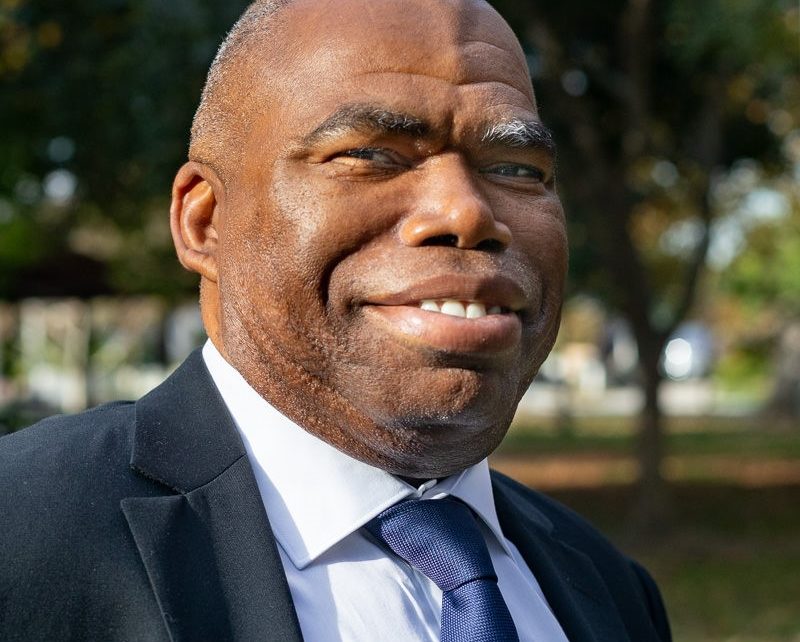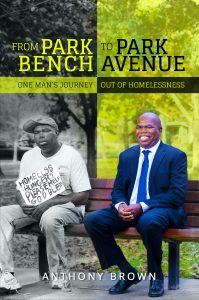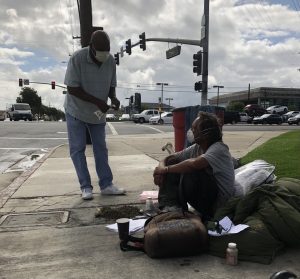
Anthony Brown is the founder and director of Coordinating & Assisting Recovery Environments (C.A.R.E.). (Photo: Anthony Brown)
HOMELESSNESS: Former Incarcerated, Drug Addict and Dealer Shares Story of Sobriety and Success
‘We need people to go into the jails and prisons and intervene before the person is released’
By Ramona Russell, April 17, 2021 2:28 am
Anthony Brown, who was a homeless, alcoholic, drug addict and drug dealer for 23 years, says, “Jail and prison were the only things that restored me to sanity. I didn’t feel like I was arrested, but more like rescued.”
Brown, who has been sober for 22 years with multiple degrees and certifications, and is now a psychiatric technician, registered nurse, addiction treatment counselor, college professor, author, speaker and business owner explains, “Once I started using drugs, I had to be physically removed from society or my environment in order to get sober.”

Growing up in Ohio to a single mother who was an alcoholic and suffered from depression, Brown never met his father and was the victim of severe physical abuse. On many occasions, his mother used an extension cord, and he recalls his worst beating was after he had stolen money from her job. She stood on his neck and beat him so much, she needed to take a break. He ran to a friend’s house, where she followed him, beat him there and continued to beat him on the walk home. His abuse wasn’t only from his mother, but from his older sister and his teacher who spanked him, which caused him to drop out of school in the 8th grade.
By the age of 7, he was stealing alcohol and by the age of 14, he was a full-blown drug addict, which he says was the only way he could cope. “I would do anything not to feel anymore. I couldn’t kill myself because if I wasn’t successful, I would get beat. I was so traumatized that I was borderline delusional, and nobody seemed to care that I was crazy.”
When he was 8 years old, he witnessed a man being shot near his home, and when he was 9 years old, his mother was shot in the head and survived. In order to escape the chaos of his environment, Brown ran away from home at the age of 14. He lived in abandoned houses and worked for a carnival, where he slept under the amusement park rides, until he was 18 years old.
Brown then traveled 3,000 miles to California with no money, where he lived in a friend’s garage with other drug addicts, who kicked him out when he stole from them. “Addicts always have a community to go to and I always knew how to sell drugs.”
He then got a job at a fast-food place where he sold drugs via the drive-thru, “A burger with extra sauce and a bag of cocaine,” he recalls. Brown also stole from the cash registers, and eventually stole drugs from his roommate, the fast-food manager, which resulted in him losing his job and a roof over his head.
Brown’s life took a turn for the worse when his mother died of cancer, causing him to become very depressed. For the next 11 years, he would be arrested multiple times for the following: assault and battery (once on a custodial officer), resisting arrest, being under the influence of a controlled substance, possession of a controlled substance, possession of a controlled substance for sale, transportation of a controlled substance and possession of a dangerous weapon. Brown was in and out of jail and prison, for a total of almost 9 years inside. “The problem wasn’t the environment I was in; it was the environment I created around me.”
The first person to ask Brown if he wanted help was a police officer, to which he said, “Yes.” From there, he met Nancy who offered him a place at an alternative sentencing program. After detoxing in jail, a woman named Jill picked him up. His plan was to sell drugs in this residential program, but Jill asked him, “Do me a favor, if you’re going to leave, don’t jump the fence, walk out the front door,” Brown realized she was placing her trust in him and changed his mind.
Brown was put in a furnished apartment where he learned how to deal with his anger, how to do chores and pay bills. He also had to attend 12-step meetings and find employment as a requirement of being there.
After 18 months of sobriety, Brown ran into an old friend who was on parole, offered to help him get sober, started spending time with him and had a relapse with methamphetamines. He stopped praying, stopped sleeping, stopped going to meetings, lost his job and went back to dealing drugs. He would eventually be arrested again with 67 grams of methamphetamines, in addition to other charges, which resulted in a sentence of 12 years in prison. Nancy returned and offered for him to come back to the residential program. He accepted and did only 3 years of his sentence, never relapsing again.
In jail and prison, Brown was always sober, read the Bible and attended Bible study. He also says Alcoholics Anonymous works, citing “A headful of AA and a belly full of booze don’t mix.” A few years into his sobriety, Brown found himself on a park bench, asking God to prove to him he existed. In that moment he had a feeling of extreme comfort come over him. He believes everyone has their own, unique connection to God and that God has always been with him.

Brown has survived many dangerous incidents throughout his life: he was born with the umbilical cord wrapped around his neck, a car he was in while intoxicated with friends went over a hill, he fell off of a moving vehicle and lost consciousness, a man pulled a gun on him, squeezed the trigger but it didn’t discharge, he overdosed and blacked out from drugs and he was in violent riots where people were stabbed. Brown gives the credit to God for saving him every time.
Since leaving prison for the last time, Brown went back to school, managed a sober living treatment center and developed a dual diagnosis program called C.A.R.E. (Coordinating & Assisting Recovery Environments) in Southern California. This cognitive-based, educational, bridge program is for people who have mental illness and substance abuse disorders where they receive treatment and get their lives back.
Brown believes housing is a very small issue to the homeless problem and that the lax drug laws in California are contributing to the epidemic. “Our homeless numbers are growing because we are feeding into it and we have let the problem go on far too long. The programs in jail and prison work, and when you’re inside, you’re sober and you want to do good, you want to change. But when you get out, even though you have no intention of going back to jail, it’s more convenient to get drugs and be on the street. Some homeless people think why even try—I can make more money doing other things.”
Brown explains that the problem is we have no after care treatment and programs for the homeless, and there are not enough transitional programs when you’re released from jail, prison or any institution. “If you take a large group of homeless people and put them in a new environment, you just get a new homeless environment. But if you take a few individuals and get them to understand the importance of getting off drugs and taking medication, they will want to do it.”
His extensive work with drug addicts and the mentally ill has shown Brown the solutions to homelessness. “We need people to go into the jails and prisons and intervene before the person is released, and then keep up with the person when they get out. We need to bring treatment to the streets and have centers where the homeless can attend meetings. And we need more places that will hire felons to help them find their identity.”

Currently, Brown is working on a rehabilitation facility to help the homeless called Brown Manor. The idea came to him when his older brother, who was still homeless and a drug addict in Ohio, was living in a doctor’s office. He bought an abandoned mansion there, which is now in construction, with plans to house a small group of homeless people. There will be a house manager and the residents will be tasked with taking care of the property while they get their lives in order. Brown says this place will offer a hand up, not a handout.
All proceeds from his book, “From Park Bench to Park Avenue,” will go toward transforming the facility.
“My contribution to this crisis is to show that there is a solution,” explains Brown. “I have lived through trauma and discovered resiliency. I have lived through addiction and discovered recovery. I have been incarcerated and found rehabilitation. I have been homeless and found residency.”
“A prison record doesn’t prevent someone from being successful in life. It just slows you down and makes you jump through hoops.” Brown received his GED in county jail and when he became sober, he went back to college after previously struggling to get past the first semester. He holds the following degrees and certificates: Licensed Psychiatric Technician (LPT), Registered Nurse (RN), Public Health Nurse (PHN), Associate in Arts (AA), Associate in Science Degree Nursing (ADN), Bachelor of Science Degree in Nursing (BSN), Certified Addiction Treatment Counselor 3rd Level Nurse (CATC III N), Certified Anger Management Facilitator (CAMF) and Director of Nursing Services (DON). He is currently working on becoming a Certified Domestic Violence Specialist and has gone back to school to become a Family Nurse Practitioner (FNP).
Brown concludes, “Facing childhood abuse, being homeless, addicted and slightly psychotic was a tough pill to swallow. I want those who are afraid to look inward, to understand there is a reason why the world that we live in is a by-product of what we have allowed ourselves to create. Pain is a touchstone of growth; however, suffering is optional.”
- HOMELESSNESS: Former Incarcerated, Drug Addict and Dealer Shares Story of Sobriety and Success - April 17, 2021
- The Most Important California Proposition You Will Vote On - October 26, 2020
- How Prop. 47 Fueled the Homeless Epidemic - February 24, 2020





Thanks Ramona for this insightful article. I loved his quote, “The first person to ask Brown if he wanted help was a police officer”. Our local police offer services, hotel vouches, and help to the homeless on the Sacramento streets all the time. I wish there were more like Mr. Brown that would say yes instead of continuing to live in squalor and commit crime.
Dear Ramona,
Thank you for sharing Anthony Brown’s story. It is quite remarkable in what he has accomplished with a second chance. He certainly overcame many obstacles and demons. God had a greater plan for him and now Mr. Brown will save many lives. God’s forgiveness and agape feeds personal growth and strength.
He should be on Governor Newsom’s Homeless Commission instead of Mayor Steinberg!
I too believe that in order to change, one needs to change their environment. It would be wonderful if our current government would change course and not cater to the drug addicted with free, safe., spaces to continue a lifestyle that will end in death and despair. Yet, the power machine of the Homeless Industrial Complex will continue to complicate this complex issue. Where is the humanity in that!
It is nice to read your writing once again.
Thanks for the good news! With God anything can be done.